Updated on: Mar 17, 2024
A significant number of our clients work through their own limited company. Typically, the company has a single director and a single shareholder, and in both cases this person is the contractor.
Every day we set up new private limited companies for our clients as part of our free onboarding process which is a process our clients enjoy because it is hassle free for them and they benefit from our expertise and guidance in setting up a new limited company online for them. Once the company is set-up the client can then immediately apply to open a business bank account.
It is also not uncommon for us to sign up a new client who has already formed their own limited company online, and the onboarding process for these clients is also straightforward. Sometimes a client will form their limited company themselves if they’re just starting out and don’t yet require the services of an accountant, or if they are testing the waters to see if then move into contracting will be successful.
If you’re just starting out contracting and looking to form your own limited company without using our free company formation service, our article Forming a Limited Company here will provide you with all the information you need to form your company in the same way that we form companies for our clients on a daily basis. We also have an additional article that discusses closing down your limited company.
The history of company formation at No Worries
These days the formation of a limited company in the UK is extremely straightforward and can be done entirely online. When our No Worries accounting service was first launched in 2005 the formation landscape was vastly different.
To set up a limited company back then there were several documents that you needed to prepare, you needed a solicitor to witness the signing of the documents, and then they would be posted off to Companies House for the application to be processed.
Each week what we would do is think up a large number of company names, prepare all the documentation, and then take a pile of paperwork down to the local solicitors office for signing so that the formation application could be sent to Companies House. In doing so we always had a file of dormant shelf companies, who got their name from literally just sitting on the shelf waiting for a new client to come along and start using it.
Generally speaking, the client would be sent a list of available companies, and they would choose the name that appealed to them the most. Sometimes they would change the name of the limited company, but with further paperwork, signatures, and post required it was often seen as too much of a burden to bother with.
Happily, the days of bulk company formations and thinking up a new list of limited company names every Monday is behind us, and we no longer need to make our way down to the local solicitor’s office for a bulk signing session.
Company formation agents
Let’s just quickly touch on the job of a limited company formation agent. When you perform a Google search for anything related to the formation of a limited company in the UK the first set of results will always be advertisements from company formation agents.
We have used company formation agents in the past but our preferred method of forming private limited companies these days is through the www.gov.uk website. We will explain the process below.
That is not to say that a limited company formation agent does not have their place, and a lot of them offer a slick online service that is easy to understand and quick to process. But what we tend to find is they include various add-ons to the formation process that are generally not required by clients like ours who are contractors that work through their own limited company.
Forming a private limited company
Every company that we form for our limited company contractor clients is a private limited company. Private simply means that it is not a public company, and a public company is one of those firms that you see registered on the London Stock Exchange for example (or an alternative trading platform).
The steps below will cover how to set up a limited company in the UK for a fictitious contractor Helen Gardener and who is looking to start trading through a new limited company that she would like to call Helen Galactic Consulting Ltd.
Step 1
Helen goes https://www.gov.uk/limited-company-formation/register-your-company and ensures she meets the criteria and has the required information at hand. Note that the actual formation process (once completed online) only takes around 24hrs, and costs £12.
Step 2
Helen then clicks the “Register Now” green button to get things underway. The first few questions are straightforward.
(a) Are you starting a new application? Click Yes
(b) Check before you start. Read the contents of this page and then click “Continue to questions”
(c) Are you able to pay for this application using a card or PayPal? Ensure you have a debit or credit card (or PayPal account) on hand to make the payment for £12. Click “Yes”.
(d) Are any directors or ‘persons with significant control’ on the Companies House secure register? Because Helen is both sole director and sole shareholder then she is a “person in significant control”. This information is displayed on the public record with Companies House and the purpose of this question is to determine if that information should be displayed publicly or not. As the question states this question is for victims of threatening behaviour or violence who cannot risk having their home address information on the public register. In this case Helen clicks “No”.
(e) You will now create a Government Gateway user ID for this company. To continue the process Helen needs to set up a government gateway user ID. This is extremely useful as it also Helen manage the limited company taxes online once a company starts trading. To continue click the “Create Government Gateway user ID” button.
(f) Enter your email address. This will only be used to send you security updates or if you need to recover your sign in details. Helen adds her email address.
(g) Enter code to confirm your email address. Helen received a confirmation code to her email address, which she enters onto this screen, and clicks “Confirm”
(h) Email address confirmed. The code is correct, so she can progress onto the next step by clicking the “Continue” button.
(i) What is your full name? Here Helen adds her full legal name as identified on her passport/drivers license, and clicks “Continue”
(j) Create a password. Now she must create a password that can be used to access her Government Gateway account. The password must 10 or more characters. She does this and clicks “Continue”.
(k) Your Government Gateway user ID is: This is where Helen is finally issued her Government Gateway ID which is a 12 digit number. The ID is also emailed to the email address she registered with. Now with her Government Gateway ID and password, she is all set-up to continue to form a limited company. These same credentials will be used to access the HMRC account that relates to her company taxes, so its incredibly important she keeps hold of these details. From this page she clicks “Continue”
(l) You need to set up additional security. As part of securing the Government Gateway online account, another level of security needs to be added. Click “Continue”.
(m) How do you want to get access codes? Helen gets three options here (1) Text message, (2) Voice call (3) Authenticator app for smartphone or tablet. The vast majority of our clients will go for option one because most people have a mobile phone, and getting a text message as a method of two factor authentication is easy to understand. Some clients use authenticator apps which may suit them better, but its really down to personal preference. Clients rarely take the “Voice call” option. In this case Helen selects the “Text message” option and clicks “Continue”.
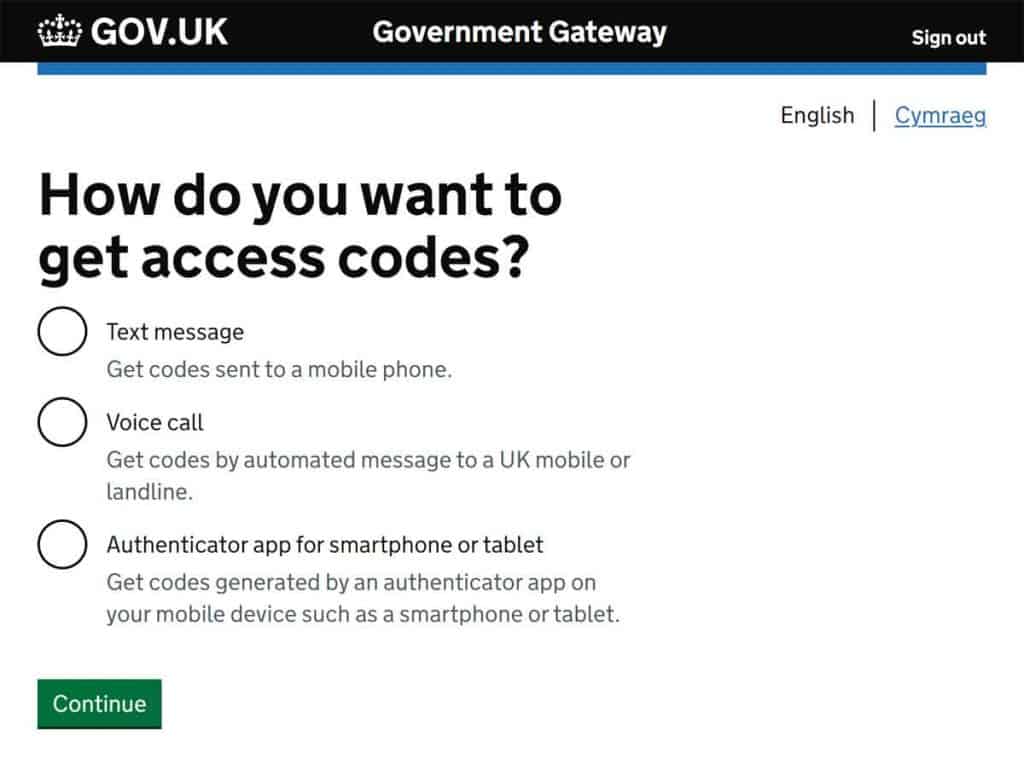
(n) Are you adding a UK mobile number? The service accepts both UK and non-UK mobile numbers. Helen has a UK mobile so she clicks “Yes” and “Continue”.
(o) Enter a UK mobile phone number. Here she enters her UK mobile number and clicks “Send access code”
(p) Enter the access code. A 6 digit code was sent to Helen’s phone by text message. She gets the code from her phone and adds it here, then clicks “Continue”.
(q) You’ve set up additional security. This is a confirmation screen only. Helen reads it and then clicks “Continue”.
Phew!!! Ok, that is the first phase complete. You can see there is quite a few steps to getting a Government Gateway account set-up, but it lasts for the entire life of your company and you only need to do this once. Believe us, once your company starts trading this account will be invaluable for tracking your limited company taxes online.
Step 3
After Helen clicked the “Continue” button at Step 1q she was brought to the Government Gateway sign in page. Now she uses all her login credentials from above to login and continue the limited company formation process.
(a) Sign in using Government Gateway. Here she adds her Government gateway ID and password, and clicks “Sign In”.
(b) Enter the access code. A six digit code is automatically sent to her phone. She adds the Access code and clicks “Continue”
(c) Which email address do you want to use for this application? Helen can choose either her own email address, or a different one. She chooses hers, and clicks “Continue”.
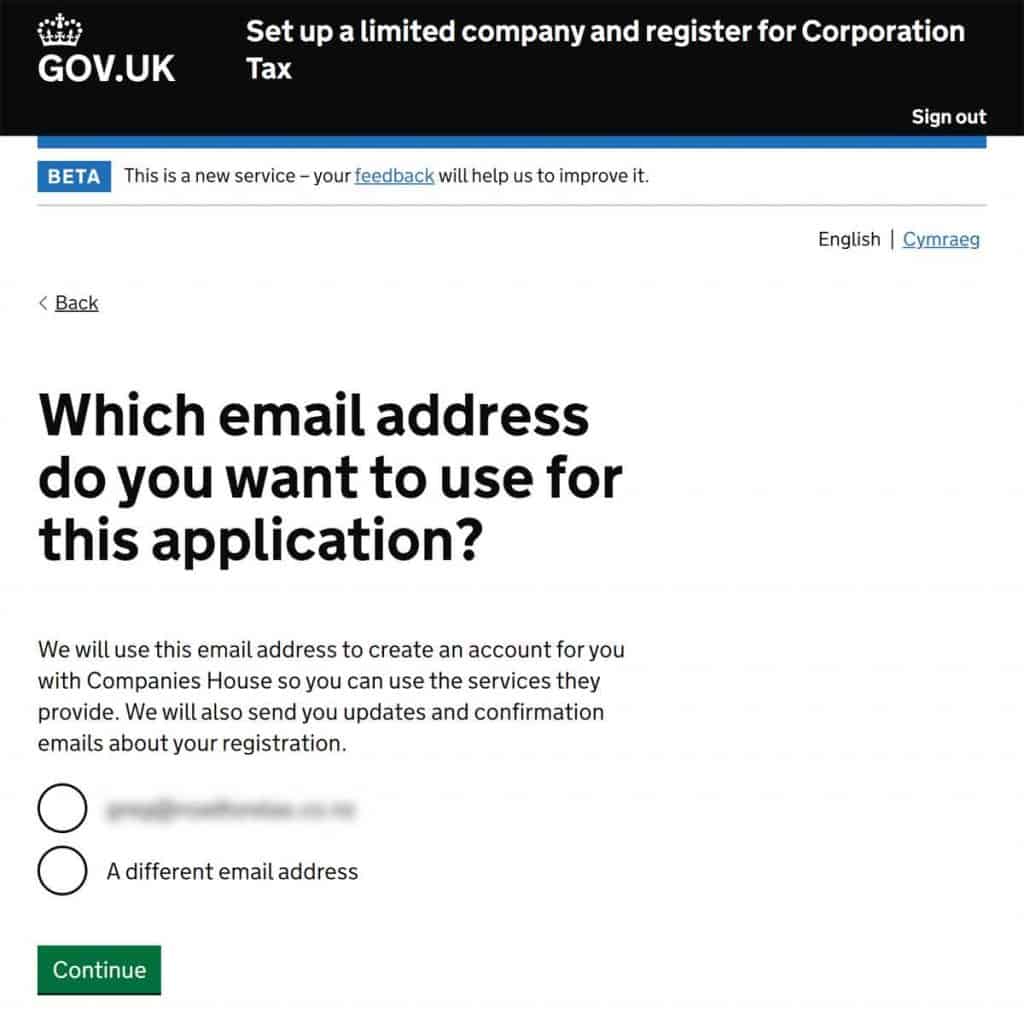
(d) What is your relationship to the company? Helen clicks “Company director” and clicks “Save and Continue”
(e) Will the company be a ‘Community Interest Company’? This is a special type of company that exists to benefit the community and it is not want Helen is wanting to form. She just wants a normal private limited company. She clicks “No” and clicks “Save and Continue”.
(f) Will the company be ‘limited by shares’ or ‘limited by guarantee’? Helen takes the usual “Limited by shares” option and clicks “Save and Continue”.
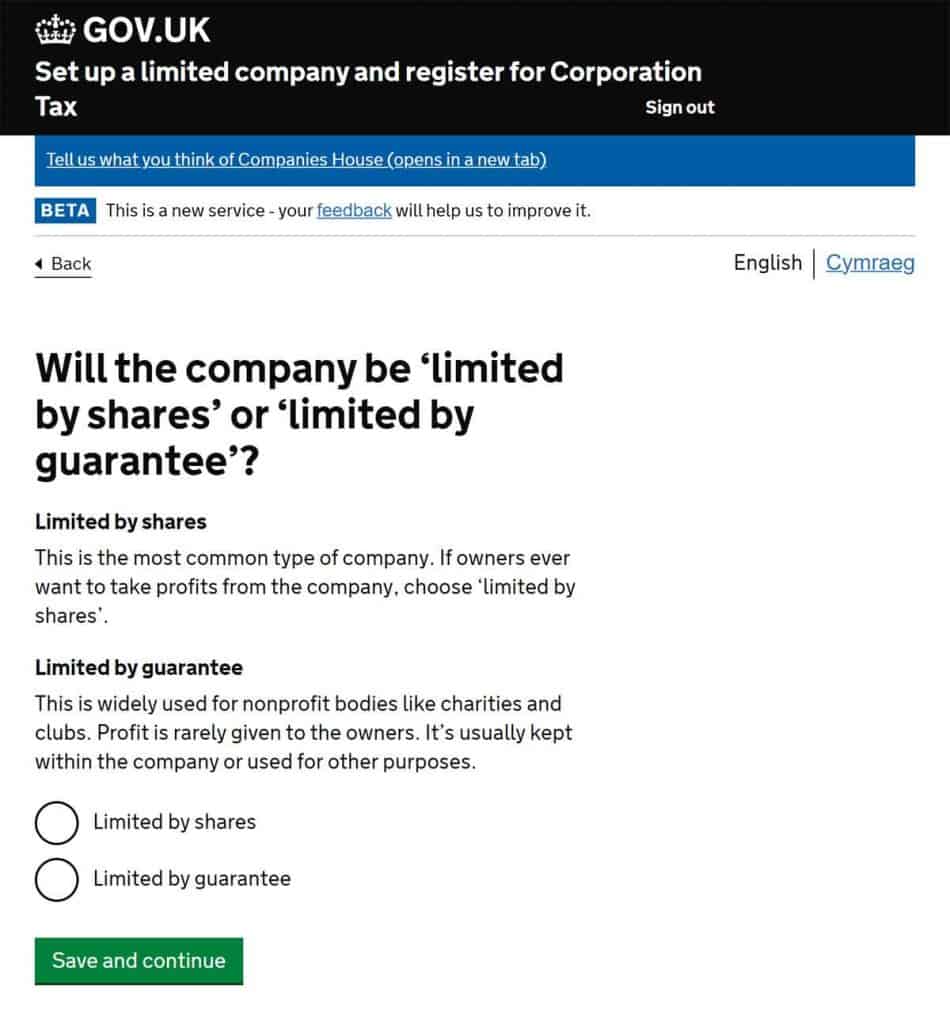
(g) Company name. Now Helen gets to choose her company name. Note that she can choose for the company to end with “Limited” or “Ltd”, it makes no difference. She adds “Helen Galactic Consulting” into the input box, selects the “Ltd” option, and clicks “Save and Continue”. IMPORTANT. At this point the portal will check the company name she added with the registered company names already on Companies House. If there is a match (or partial match) she will be alerted and may need to think of a new company name (full instructions of what to do will be shown on screen). If no match is found, she will automatically continue to the next step below.
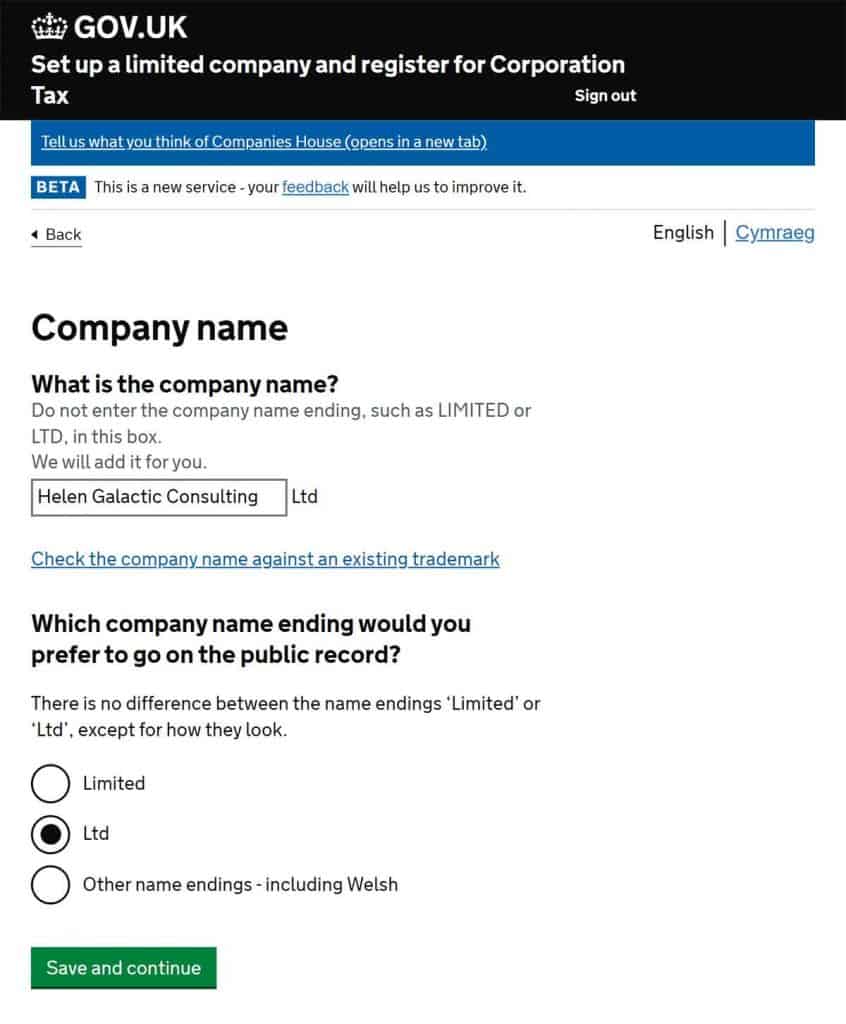
(h) What is the company’s registered office address? The registered office address used to send notifications to the company. It can be your home address, or a business address. Note that this address will be displayed on the public record. Helen adds her home address and confirms it by clicking the “Confirm and Continue” button.
(i) Where will the company be registered? This is simple to complete, just select the part of the UK where your registered office is located. In this case Helen selects “England and Wales” and clicks “Save and Continue”.
(j) What is the company’s ‘principal place of business’? This is where the company will carry out most of its business activities and it does not go on the public record. Helen selects her home address here and and clicks “Save and continue”.
(k) Give us one or more ways to contact HELEN GALACTIC CONSULTING LTD. Here they want at least one form of contact info for the company, in case the HMRC have any corporation tax questions. Regardless of the info used to form the company, this is a separate request made for contact info that can be sent over to the HMRC. When a new company is formed in the UK it is automatically registered for corporation tax which is why this question is here. Helen adds the email address she used for this registration process, and clicks “Save and Continue”
(l) Is the new company replacing another business? This is a brand-new company Helen is creating with no trading history as part of another entity or trading structure, so she clicks “No” and then “Save and Continue”.
(m) When will the company start trading? This question is used by the HMRC to determine when it must start paying corporation tax from. At this point Helen does not know the exact date (she can always update the HMRC later) so she selects “No plans to start trading or do a business activity yet” and clicks “Save and Continue”.
(n) In its first 3 months will the company do any of the following? This is the HMRC just trying to get a few more details about the business to ensure business income is being reported correctly. None of these relate to this new company so Helen clicks “No” and “Save and Continue”.
(o) What will the company be doing? This question is used to determine the SIC (Standard Industrial Classification) code that relates to the business and this is generally used for for statistical purposes. The SIC code can also be used by banks, creditors, and insurers to make informed decisions about risk in relation to the sector the company operates in, but for a company like this one, it is pretty much just for statistical purposes. For Helen she selects “Engineering related scientific and technical consulting activities” and then clicks “Save and Continue”.
(p) Check and confirm what your company will be doing. This just confirms the selection from the previous page, and informs Helen she needs an Economic Operators Registration and Identification number (EORI) if she is moving goods into or out of the EU. Helen provides services, not goods, so she just clicks “Confirm and Continue”.
(q) Has anyone on this application ever sent a Secure Register form to ask Companies House for protection? This is very similar to the question asked in 2d above. Helen gives the same answer “No” and clicks “Save and Continue”.
(r) Director’s details. Finally, we are at the page where the Directors details get added. As a director, Helen has legal responsibilities for running the company and making sure information is sent to the HMRC and Companies House on time. We must specify at least one director, and here Helen adds her personal details as company director and clicks “Save and Continue”.
(s) What is the correspondence address for Helen Gardener? Here she just selects the same home address that she has been using throughout this application and clicks “Save and Continue”. Note this address will be publicly viewable on the Companies House website.
(t) What is the home address for Helen Gardener? Here she just selects the same home address that she has been using throughout this application and clicks “Save and Continue”. Note this address will not be publicly viewable on the Companies House website.
(u) Does Helen Gardener want to receive filing reminders by email? Companies House will sent out filing reminders on a periodic basis. Its worth getting these, so Helen selects “Yes” and clicks “Save and Continue”. In the next screen she is asked to confirm what email address should be used, so she selects the email address she used for registration and clicks “Save and Continue”.
(v) Do you want to add another director? We are only adding one Director, and Helen clicks “No” and then “Save and Continue”. An additional company director can always be added later.
(w) Check and confirm director details. This is a confirmation screen that displays all the info previously entered. Just check the details and then click “Save and Continue”.
Step 4
Great. We have now got the company name and directors all set-up, and provided some preliminary information that the HMRC can use in relation to trading income and corporation tax. You will note that Helen has not set-up a company secretary for her business, and for the time being that is fine. A company secretary is not a requirement.
Now lets set-up the online filing authorisation for this company, so that you can digitally authorise directors to file information online with Companies House.
(a) You’re about to set up online filing authorisation for the company. This page sets up the next step. Helen reads its contents and then clicks “Continue”.
(b) Do you want the directors to be digitally authorised to file online for the company? Simple answer is “Yes”.
(c) Which directors do you want to digitally authorise to file online? We only have one director here to choose so its nice and easy. Helen selects herself on the list and clicks “Save and Continue”.
(d) Does Helen Gardener have an existing Companies House WebFiling account? This is This is used to access the Companies House WebFiling service, where you can submit company filings and updates online. At this stage Helen is brand new to all of this, so selects “No”.
(e) Which email address does Helen Gardener want to use to create their WebFiling account? Helen selects the same email address she set-up at registration, and clicks “Save and Continue”.
(f) Check and confirm authorisation details for online filing. This is just the confirmation page. All details are correct, so Helen clicks “Save and Continue”.
Step 5
We are now at the point where shareholders are set-up for the company. Whereas the directors run the company, its the shareholders who own the company. In the case of our clients the director and shareholders are usually the same person. So, let’s get on with adding a Shareholder.
(a) You’re about to set up the company’s shareholders. Helen reads the contents of this page and then clicks “Save and Continue”.
(b) Is Helen Gardener a shareholder? Simple question, and simple answer. Helen clicks “Yes” and then “Save and Continue”.
(c) Would you like to add another shareholder? At this stage the answer is No, but a shareholder can always be added later. Helen clicks “No” and then “Save and Continue”.
(d) Check and confirm shareholder details. This is just a summary page of what was added in the previous two screens. Helen clicks “Confirm and continue”.
(e) Do you want to use the most common type of shares? Helen only needs common share at this point. Sometimes different shareholders will hold shares with different rights, but here there is only one shareholder, so there is no need for this. Helen clicks “Yes” and then “Save and Continue”.
(f) How many shares does Helen Gardener own? Here you get to choose how many shares you wish to own. It could be 1, 10, 100, or literally any number you like. We use “10” for most of our clients because it offers a little flexibility if they want to issue shares to other shareholders at some point in the future. So here Helen clicks “Other amount” and adds 10.
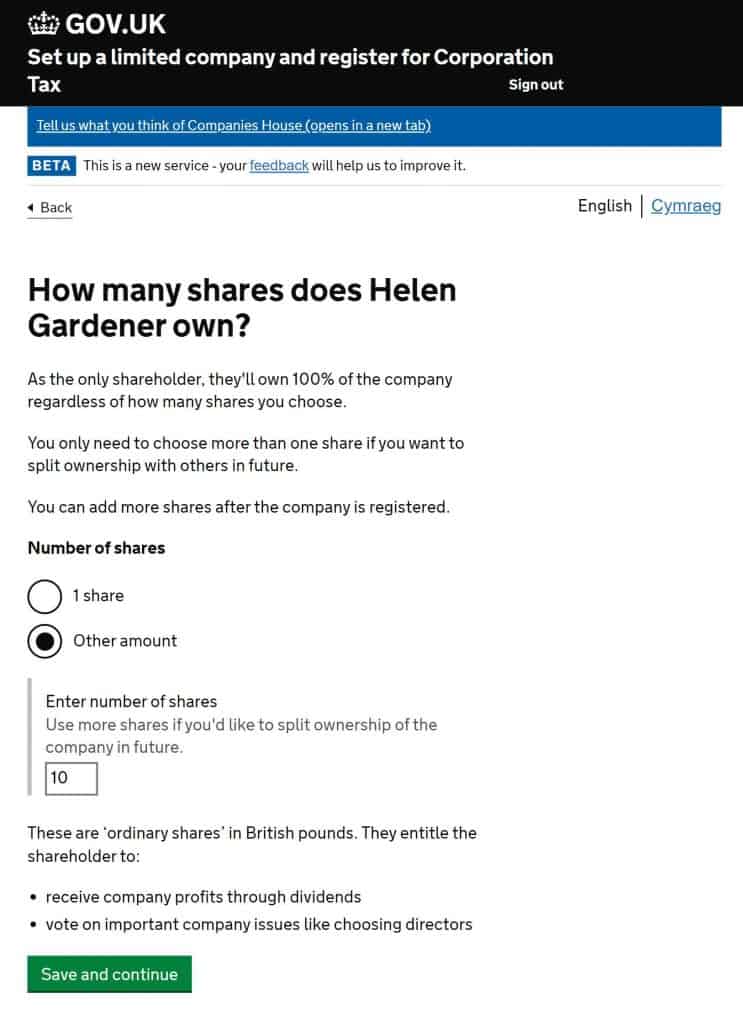
(g) Choose a value for each share. This sets the value of each share and is usually a nominal amount. We always recommend £1 to our clients. So in this case it means Helen will hold ten £1 shares, worth a total of £10. Once the company is formed, and the business bank account opened, Helen needs to pay £10 into the company bank account to “pay” for the shares she has received. Here Helen clicks “£1” and then “Save and Continue”.
(h) Check and confirm shareholders and shares. Here is another summary page that shgows the shareholder details that have been added. Check they are correct and then clicks “Save and continue”.
Step 6
When I started writing this blog I thought I would have finished this a LONG time ago. Going through each stage step by step seems to take a long time, but when you get online and start a formation yourself its alot faster than actually writing a blog about it! Anyway, the next step is to set up the ‘Persons with Significant Control’ (PSC) over the company.
(a) You’re about to set up the ‘Persons with Significant Control’ over the company. This page sets up the next step. Helen reads its contents and then clicks “Continue”.
(b) From your previous answers we know that Helen Gardener is a Person with Significant Control. Helen reads its contents and then clicks “Continue”.
(c) Does Helen Gardener have the right to appoint or remove the majority of company directors? As sole shareholder the answer here is Yes.
(d) Check and confirm details of the persons in control of HELEN GALACTIC CONSULTING LTD. This is a summary page of the details previous entered by Helen, but that relate to PSC issues. Helen checks the details and then clicks “Save and continue”.
Step 7
Now we need to get the article of association sorted out for the company, and the memorandum of association. Luckily there is a “model” set of articles that can be used for most businesses, and in the case of our contract clients, the model articles of association are perfect.
(a) Model articles of association. Here you can view the model articles of association and agree to use them. Helen clicks “Yes” and then “Save and continue”.
(b) Do you agree to form the company? This clicking the link here you are automatically preparing the memorandum of association for the company. Helen ticks the box and clicks “Save and continue”.
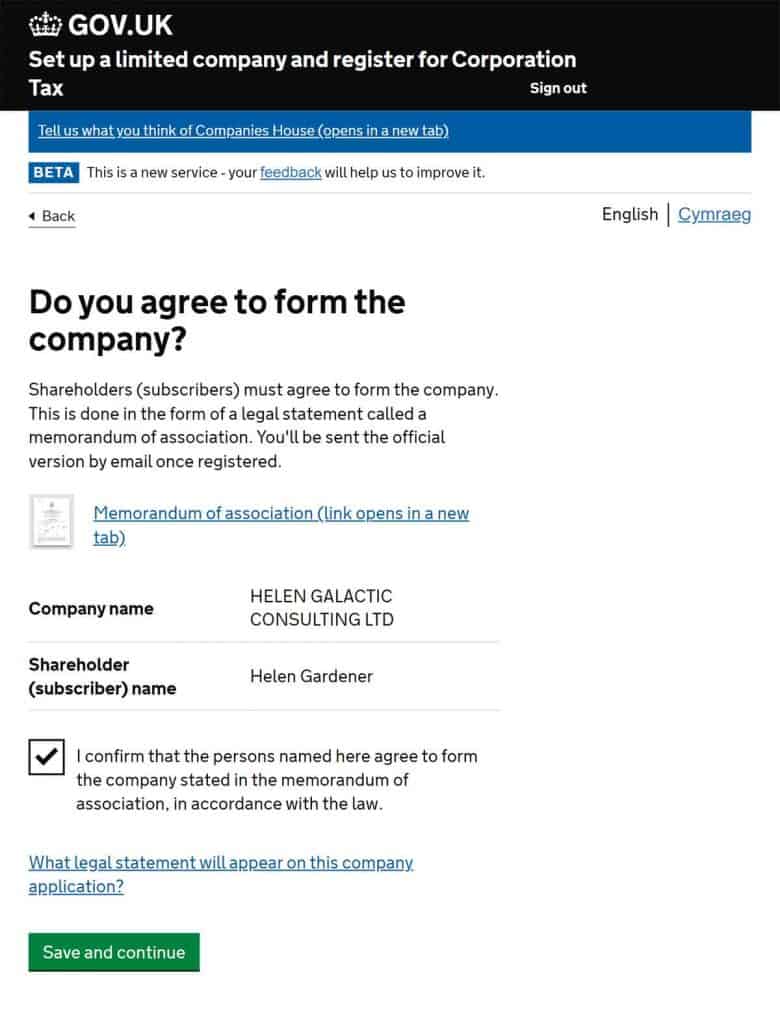
Step 8
(a) Now you must create an electronic signature. This is something Companies House use to confirm that it is actually you who is completing this information. You need to answer three of the six questions presented, and your answers combine to create your “digital signature”. Helen ticks three of the boxes and adds the information requested, and then clicks “Confirm and continue”.
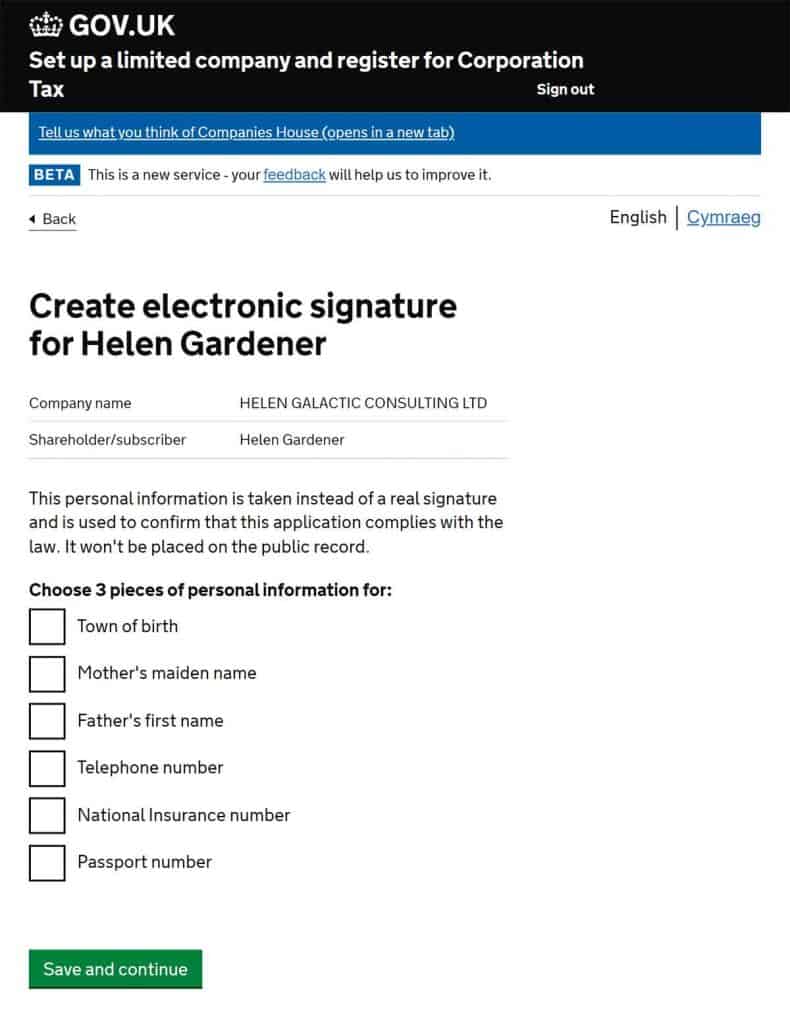
(b) And finally Helen is presented with two summary pages showing ALL the information she has submitted to date. So long as the information is all correct, she then clicks “Confirm and send application” and that will lodge the formation application with Companies House.
Step 9
Final steps are not described here, but they are straight forward. Its (a) then pay via debit/credit card for the formation (b) check your emails as you will be notified once the company has been formed.
Keep all the formation emails you will have received in a safe place, as you may need them from time to time over the years.
And above all, good luck with your ltd company!! If you need a contractor accountant, well, you know where to look 🙂

